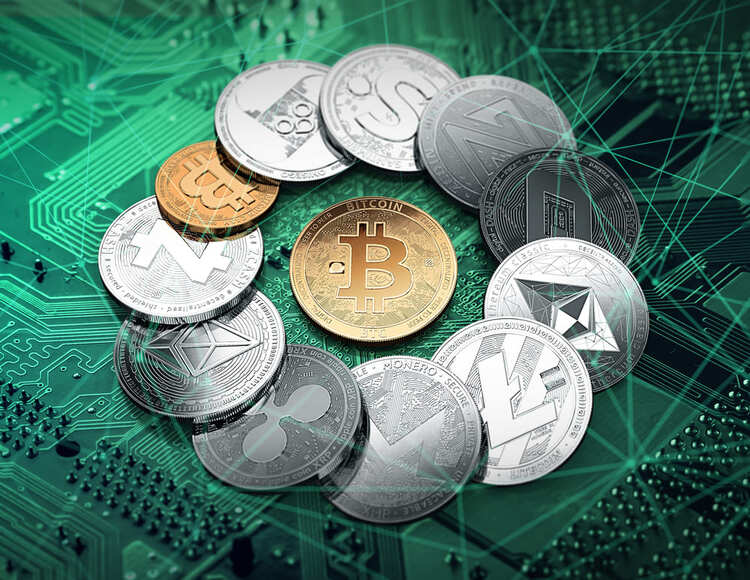What is Cryptocurrency? Features and classification of the cryptocurrency market

Several years ago, people still doubted the value of the entire cryptocurrency market. Market acceptance is growing, with the total market cap continuing to climb, especially as Bitcoin's price has broken through $60,000 and $70,000, and is predicted to advance to the $100,000 level.
However, there are still many people who are not familiar with this market. In this article, we will explain what cryptocurrency is, along with its features and main types.
1. What is Cryptocurrency?
Crypto (Cryptocurrency) is a term for a type of electronic or virtual currency designed to be used as a means of online payment. Blockchain technology encrypts it to secure and authenticate transactions.
The virtual currency market (also known as the Cryptocurrency market) is an emerging type of financial market in which virtual currencies are used as a form of payment or to develop blockchain project systems .
Key takeaways:
|
2. What can we do with cryptocurrency?
Cryptocurrency offers a wide range of possibilities beyond simple transactions. Users can invest in digital assets, potentially benefiting from price appreciation over time. Many people use cryptocurrencies for online purchases, taking advantage of lower fees and faster transactions compared to traditional banking methods.
Cryptocurrency can be utilized in various ways, including:
Investing: Many people buy cryptocurrencies as an investment, hoping their value will increase over time.
Transactions: You can use cryptocurrencies for peer-to-peer transactions without intermediaries, often at lower fees than traditional banking.
Remittances: They offer a fast and cost-effective way to send money across borders.
Decentralized Finance (DeFi): Users can lend, borrow, and earn interest on their cryptocurrency holdings through decentralized platforms.
Smart Contracts: Some cryptocurrencies, like Ethereum, allow for the creation of smart contracts that automatically execute when conditions are met.
Non-Fungible Tokens (NFTs): Cryptocurrencies can be used to buy, sell, and trade NFTs, which stand for ownership of distinct digital assets.
Staking: Holding certain cryptocurrencies can earn rewards through staking, helping to ensure network security.
Charitable Donations: Many organizations accept cryptocurrency donations, providing transparency and lower transaction costs.
Gaming: Cryptocurrencies are increasingly used in online gaming for in-game purchases and rewards.
Privacy Transactions: Some cryptocurrencies focus on providing enhanced privacy features for users.
Cryptocurrencies are used for various purposes, including investment, online transactions, and cross-border value transfer. However, they also come with risks, such as volatility and regulatory uncertainties.
3. Features of the Cryptocurrency market
The cryptocurrency market has several distinctive features that set it apart from traditional financial markets:
Security: Transactions with Cryptocurrencies are encrypted using blockchain technology, ensuring safety and security for users.
Decentralized: Unlike traditional currencies, virtual currency transactions are conducted directly between users, without any third party intervention.
Independence from Governments and Central Banks: Cryptocurrencies are not dependent on any government or central bank. The management of Cryptocurrencies is completely independent and is decided by the issuing team and the user community.
No geographical restrictions: Since the Cryptocurrency market operates online, users can access and use Cryptocurrencies from anywhere in the world.
High volatility: The Cryptocurrency market is highly volatile, with prices of Cryptocurrencies changing dramatically in a short period of time. This creates opportunities for experienced investors, but also means high risks.
Fast transaction speed: Cryptocurrency transactions are processed quickly across borders and in seconds.
Potential for value creation: Cryptocurrencies have the potential to create value for their owners by participating in education, contributing to community development, and investing in new projects. However, traders need to carefully research and be aware of potential risks when participating in new blockchain projects because the success rate of new projects is quite low.
These features contribute to a dynamic and rapidly changing market landscape, attracting both investors and innovators. More details about Cryptocurrency market classification will be introduced in detail in the next part of the article.
4. Classification for Cryptocurrency market
The Cryptocurrency market can be classified in many different ways. Here are some common classifications:

Bitcoin and Altcoins: Bitcoin is the first and most well-known cryptocurrency, while altcoins refer to all other cryptocurrencies.
Stablecoins: These are pegged to stable assets (like fiat currencies) to reduce volatility, such as Tether (USDT) and USD Coin (USDC).
Coins and Tokens: Coins are digital currencies that operate on their own blockchains, such as Bitcoin (BTC) and Ethereum (ETH). In contrast, tokens are created on existing blockchains and represent assets or utilities, like The Sandbox (SAND).
Utility vs. Security Tokens: Utility tokens provide access to a service such as Golem (GNT), while security tokens represent ownership in an asset such as Polymath (POLY).
*Note: The names of the stablecoins and tokens mentioned above are provided solely as examples and should not be construed as investment recommendations.
#Coin vs Token
The Cryptocurrency market is classified according to each specific type of Cryptocurrency:
Coin | Token |
Coin is an independent virtual currency, issued on a separate blockchain, functions as a unit of payment, is accepted on many different Cryptocurrency exchanges, and has its own market value. | Token is a virtual currency issued on an existing blockchain such as Ethereum, Solana… Tokens are often used to represent the right to use a service or product, can be traded on electronic exchanges or used internally within a blockchain project. |
For example: Bitcoin (BTC) , Ethereum (ETH) , Litecoin (LTC) , Ripple (XRP) , Cardano (ADA) … | For example: Axie Infinity (AXS) , Smooth Love Potion (SLP) , The Sandbox (SAND) … |
Additionally, we can categorize tokens based on their specific application or service:
#Utility Token vs Security Token
Utility Token | Security Token |
A specific application or service uses these tokens to perform functions. | This type of token represents a specific asset, often ownership rights in a company or other asset. Security tokens have similarities to securities and must comply with financial regulations. |
Examples include Golem (GNT), Augur (REP), or Basic Attention Token (BAT). | Examples include tZERO (tZERO), Polymath (POLY). |
5. Summary
Cryptocurrency is a digital or virtual form of currency that uses cryptography for security. It operates on decentralized networks based on blockchain technology, which ensures transparency and security in transactions.
The cryptocurrency market is dynamic, with ongoing innovations and shifts in regulation, making it a complex but intriguing financial landscape.
6. FAQs
#Is cryptocurrency safe to use?
While cryptocurrencies offer strong security features, such as cryptographic encryption, they are not without risks. Users must take precautions like using secure wallets, enabling two-factor authentication, and being aware of scams and phishing attempts.
# What is blockchain technology?
Blockchain technology is a decentralized digital ledger that records transactions across multiple computers. It guarantees the security, transparency, and immutability of the data, preventing any alterations once recorded.This technology underpins most cryptocurrencies.
#How can I store my cryptocurrency safely?
Cryptocurrency can be stored in digital wallets, which come in various forms:
Hot wallets: Online wallets that are connected to the internet, making them convenient but potentially less secure.
Cold wallets: Offline wallets, such as hardware wallets or paper wallets, that offer enhanced security by keeping your assets away from online threats.
Before making any trading decisions, it is important to equip yourself with sufficient fundamental knowledge, have a comprehensive understanding of market trends, be aware of risks and hidden costs, carefully consider investment targets, level of experience, risk appetite, and seek professional advice if necessary.
Furthermore, the content of this article is solely the author's personal opinion and does not necessarily constitute investment advice. The content of this article is for reference purposes only, and readers should not use this article as a basis for any investment decisions.
Investors should not rely on this information as a substitute for independent judgment or make decisions solely based on this information. It does not constitute any trading activity and does not guarantee any profits in trading.
If you have any inquiries regarding the data, information, or content related to Mitrade in this article, please contact us via email: insights@mitrade.com. The Mitrade team will carefully review the content to continue improving the quality of the article.






